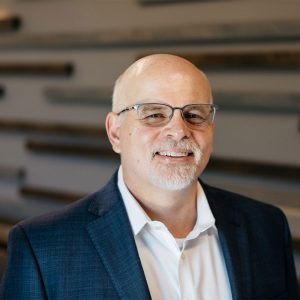You may remember reading about our President & CEO, Jeff Morris, in a blog post about Ntara’s history and how he and Neil brought their vision to life. In this blog post, we’re taking yet another peek behind the scenes, but this time, Neil is our tour guide.
As I walk into Neil’s office to begin the interview, I notice a few things. There is calming music playing in the background, the lighting in his office keeps changing – he has this really cool piece on the wall that changes colors and illuminates the entire room depending on the mood. Just trust me, it’s cool. There is a replica of BB-8 [the Star Wars character] right beside the door. The picture hanging above his desk is a chaotic street scene of Grand Central Station with a faint sunset in the background. I imagine this reflects what it’s like to be inside his brain—constantly moving and always focused on the big picture. I see so many toy cars and Marvel figurines that I can’t take them all in. Then there is a sea of pictures of his family—the day he and his wife, Lisa, married, school pictures of his children, and artwork they have created just for him. Then, I notice he is smiling. Before I could snap out of it and say something, he blurts, “Is it time? I’m ready!”
And off we went…
Do you have anything you want to add to the story Jeff told on how Ntara was born?
I really loved the world of academe and the experiences it brought me. The growth of the Advanced Visualization Laboratory program at ETSU—which grew from 40 students to almost 500 very quickly—kept me extremely busy and was exhilarating to be a part of its creation and evolution.
Amongst all the success, excitement, and growth of the program, there was also this tectonic pressure between wanting to continue building the academic program and the lure of the private sector. We were losing the best and the brightest to the west coast and were eager to find a way to keep talent in our area.
So, when Jeff proposed the idea of Ntara and we found strong support from regional business and community leaders — two weeks after I received tenure from the university—I made my decision. I was going to take that leap.

Before we go any further, I want to back up a little bit and dive into your background. What are you passionate about?
I completed my undergrad at Purdue. I started in engineering, but it just didn’t feed my heart. So, right before I planned on leaving school for good, I met someone who told me about industrial design. I fell in love with everything it was about—this fantastic melding of form, function, art, technology, and manufacturing all in one.
After working for a few years as an Industrial Designer, initially at General Electric and ultimately in Detroit; I went back to Purdue for my master’s degree and that’s when I discovered my true passion: 3D animation. It was new and exciting, technical and creative, and it fueled my fire.
When I began looking for jobs in higher education, I spoke with Purdue—which seemed like a no brainer to some—and East Tennessee State University (ETSU)—a university unheard of to most in West Lafayette, Indiana.
Coincidentally, I was having a conversation with one of my classmates at Purdue, Derek Eggers, about my interest in teaching when he told me his father was a professor and the head of the graphics program at ETSU. He encouraged me to talk to him about the world of academe. So, I did. And just like that, ETSU was on my radar.
Purdue offered me a tenure-track position, lab space, classes to teach, mapped out syllabi, and basically anything I needed to start my journey. Dr. Jerry Eggers, Derek’s father, on the other hand, gave it to me straight. He told me that ETSU didn’t have the bells and whistles at the time, but they would help transform my dream of a cutting-edge 3D design and animation program into a reality. This intrigued me and ultimately, that’s what got me to Johnson City.

What drew you to this area and what has kept you around?
Honestly, they are one in the same. It’s the people. They are truly authentic. They have a tremendous work ethic and are some of the most compassionate people I’ve ever met. A compassionate community isn’t something you can easily see or touch. You must be here for a little while and engage with the people before you can really begin to comprehend the magnitude and the depth of a caring community. And, man, once we built these relationships, you just don’t want to leave.
What obstacles do you see within our industry coming down the pipeline? How will Ntara rise to the challenges of those obstacles?
There are many challenges: changing technology, growth, a truly integrated global economy, digital security; but if there is one thing I’ve learned in 19 years, it’s that we’re not afraid of a challenge. We’re problem solvers, bridge builders, and we’re very good at it. (We just built a Kentico & inriver connector. The ultimate bridge. Check it out.)
Building bridges between business and technology or businesses and their customers has always been our goal. As educators, Jeff and I have taken the approach of building people, as well, because we know that is the foundation of success for us. So, what we look for are really smart people who have a good heart and a lot of compassion, who care about their quality of work and aren’t afraid to work hard.
Wisdom is knowledge, seasoned with pain.
Neil Owen – CSO & Co-founder
Tell me about the struggles you’ve faced throughout the course of Ntara’s history.
Most companies experienced the [recession] struggles of 2008 and 2009, we did too. We had to build yet another bridge—this time it was for ourselves.
We had two divisions of the company at the time—the digital agency and the enterprise software group. Our software group couldn’t bring much profit to the business during those years, but we knew how incredibly valuable they were. They understood the requirements to deploy rock, solid software for the Fortune 500 and work hand-in-hand with these organization’s IT department. So, we asked them to help us build this bridge. A bridge that would utilize their expertise and make us better. Ultimately, merging the two divisions was one of the best decisions we’ve made. Ultimately, it dramatically raised the standard and capabilities of our digital agency.
Talk about Ntara’s milestones. What have we accomplished that you’re really proud of?
The original plan was to grow the company and sell it in 5 years. We started to grow and the .com bust happened. Then, another company invested, but tried for a takeover, so that didn’t work. Then, we had the economic bust of 2008. After many ups and downs, we decided. We wanted to make the company a great place to work and, of course, one that is profitable—but we knew then that we didn’t want to sell anymore, we wanted to thrive.
Fast forward to 2017. Our “for sale” sign came down. Talk about a milestone.
Once Jeff [CEO], Buddy [CFO], and myself acquired full ownership of the company, we felt as though we could grow in a healthy way. Now, we thought, we can steer the ship.
What are you excited about for the future?
I have never been more excited about the future.
I feel like there are a lot of things happening (globally) that we’re in a good place to capitalize on. Our ability to do deep integration is key. We can make things beautiful and great for user experiences but, most importantly, we can create digital ecosystems that work well together.
It’s not a brochure website world anymore. It’s about digitally transforming business, and businesses are hungry for that. We now have the unique opportunity to capitalize on that and help people around the world. That’s very exciting.
We’re excited about the year ahead and want to make sure you stay on top of all the most recent Ntara news. Follow us on Facebook, Twitter, and LinkedIn!
